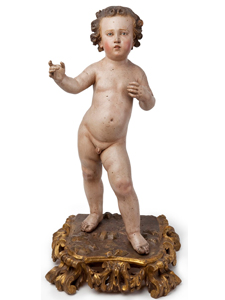The Christ Child (Hall 27)

One of the most widely recognized names from the Spanish Baroque period is Francisco Salzillo. The son of a Neapolitan sculptor, he was born in Murcia in 1707. When his father died, he took over as director of the workshop, which continued to grow, with an emphasis on religious themes. He is known mainly as a sculptor of processional figures for Holy Week and of small figures for nativity scenes carved in the tradition of Neapolitan creche makers.
This artist created the prototype of a child, which he often used for the figure of the Baby Jesus or a small angel. He adapted the form to meet his diverse iconographic needs. These are children with rounded features, modeled with care to capture a child's anatomy and pink flesh.
Through the identification of these characteristic features, this piece has been attributed to Salzillo. The figure, shown in a marked contrapposto, looks up with a sad gaze. This leads us to believe that he must have been looking at a crucifix he once carried in his right hand, which is now lost. His passionate gaze would have caused this expression of sadness. It is believed that this image is from the mid 18th century, the period when Salzillo carved the mournful angels which accompany Our Lady of Sorrows, carried in procession by the Confraternity of Jesus in Murcia.
Images of the Christ Child were quite common in the oratories of convents, and many of these were dressed in accordance with the liturgical era. The Museum has a fine collection that spans from the 15th century to the 18th century. It shows the different iconographic styles that were used, from the Christ Child as Savior to the Christ of the Passion.


